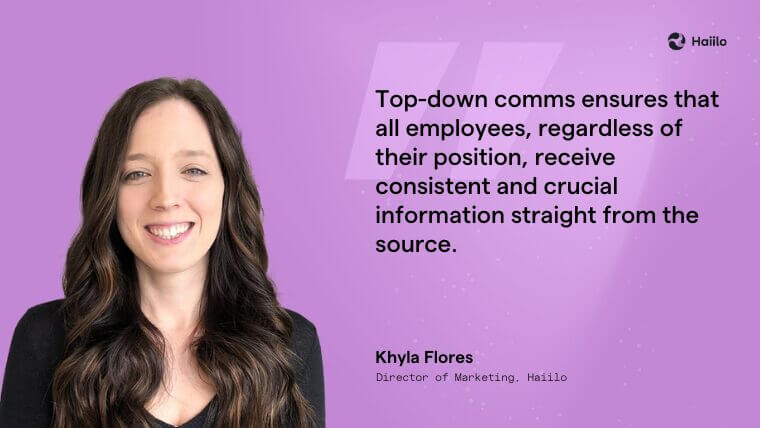Against the backdrop of today’s fluid workspaces, with teams dispersed across various locations and navigating a mix of return-to-office (RTO) policies, flexible work arrangements, or fully remote roles, we often find ourselves confronting a deluge of information and application overload. In this context, the significance and importance of a robust internal communications strategy have become increasingly evident.
Amidst a plethora of touchpoints and sources competing for our attention, the challenge for Communications Managers to cut through the clutter and ensure that the right information reaches its intended audience in a digestible manner has become crucial. This evolving landscape demands a sophisticated approach to internal communications, one that not only disseminates information but also fosters engagement and actively listens to employees, thereby creating a seamless flow of communication.
Haiilo’s modern intranet solution makes it easy to inform, engage, and listen to your employees with one platform.
The Three-Step Communication Cycle
This flow, underpinned by a three-step cycle, demonstrates a profound understanding of the challenges and opportunities within today’s corporate sphere. It aims to narrow the gap between the surplus of information and genuine engagement.
The cycle initiates with top-down communications to guarantee that employees are thoroughly informed, laying down a foundational layer of awareness throughout the organization. Here, the importance of conveying clear, understandable messages is paramount, as it helps to reduce misinterpretation and align every team member with the organization’s goals and updates. When the team is united in understanding the direction and means of achieving organizational objectives, doubts are alleviated, and a synergy emerges that enhances our collective efficiency.
📚Learn more: Understanding the Different Types of Internal Communication for Your Business

Moving beyond mere information dissemination, the critical role of contemporary intranet solutions in facilitating the subsequent phase of engagement becomes apparent. These platforms provide a venue for employees to delve into the provided information, collaborate with peers, and share their insights, fostering an interactive and inclusive atmosphere. In this phase, dismantling silos and encouraging collaboration across departments, particularly within a hybrid workforce, is vital. Utilizing a variety of communication channels allows organizations to maintain consistent messaging and cultivate a cohesive workplace culture.
🧐 Check out Asynchronous Communication: What It Is and How To Make It Work
Transitioning from the engagement phase, we arrive at the pivotal step of listening. By implementing feedback mechanisms such as surveys and employee listening tools, organizations can attune themselves to employee sentiments, cultivating an environment where feedback is not just sought but also valued and acted upon. This stage highlights the necessity of embracing a people-centric approach, prioritizing the needs and viewpoints of employees over stringent processes.
The Role of Managers
Throughout this communication cycle, the role of managers remains crucial. They are the connectors ensuring the smooth transition from information to engagement to listening. Managers tackle the challenge of delivering complex information with clarity, bridging cultural and generational gaps within their teams, balancing high-tech communication tools with personal interactions, and guiding change with flexibility and empathy, especially pertinent in the current work and economic climate.
💡Want more insights? Check out We Know It But We Don’t Do It: Creating the People-Centric Approach to Change
Addressing these challenges necessitates a comprehensive approach. Providing managers with training and resources to navigate the diversity within their teams can create an environment where every employee feels acknowledged and understood. Moreover, offering a blend of communication tools and strategies enables managers to reach their teams effectively, ensuring that each message not only penetrates the noise but also resonates on a personal level.

Conclusion
In essence, the effectiveness of internal communications in the modern workplace hinges on integrating these steps—informing, engaging, and listening—into a unified strategy that harnesses modern technology while preserving the personal connections vital for a thriving workplace.
By striving to establish a communication environment that is adaptable, inclusive, and responsive, organizations can ensure that every employee feels informed, engaged, and heard, fostering a culture of open communication, collaboration, and adaptability.
🚀 Continue: 7 Internal Communication Trends to Consider in 2024
About the Author
With a career spanning over two decades, the latter half of which was devoted to digital marketing, David has led international teams in redefining and optimizing corporate MarComs and social media campaign strategies and has utilized his proficiency to navigate complex, cross-cultural landscapes effectively.
During his time at WSP Global and Fasken, he led pivotal employee advocacy programs and introduced marketing technologies that significantly elevated online engagement and brand visibility, enhancing collaboration within MarComs teams. David’s approach breaks through traditional marketing boundaries, aiming to fully utilize digital platforms’ potential.
Currently, David is applying his strategic vision and expertise to new projects, driven by his passion for empowering teams and individuals to maximize their online influence. David is deeply committed to employee advocacy, employer branding, and content marketing, demonstrating a genuine passion for enriching the digital marketing landscape with effective, thoughtful strategies.









